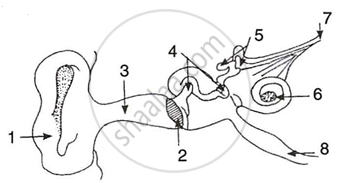Advertisements
Advertisements
Question
Differentiate between Near vision and Distant vision (shape of the eye lens)
Solution
| Near vision | Distant vision |
| In near vision, the shape of the eye lens is convex. | In distant vision, the shape of the eye lens is thin and less convex. |
APPEARS IN
RELATED QUESTIONS
find odd one from following: Malleus, iris, Stapes, Incus.
(i) Draw a well labelled diagram of the membranous labyrinth found in the inner ear.
(ii) Based on the diagram drawn above in (i) give a suitable term for each of the following descriptions :
1. The sensory cells that helps in hearing.
2. The part that is responsible for static balance of the body.
3. The membrane covered opening that connects the middle ear to the inner ear.
4. The fluid present in the middle chamber of cochlea.
5. The structure that maintains dynamic equilibrium of the body.
A fluid that occupies the larger cavity of the eye ball behind the lens is
___________.
the biological/technical terms for a thin membrane covering the entire front part of the eye.
Differentiate between the Rods and Cones of Retina (Type of pigment)
Give scientific reasons: We cannot distinguish colours in moonlight.
Note the relationship between the first two words and suggest the suitable word for the fourth place.
sound : ear drum :: Dynamic balance : ……
Where is the oval window located? Briefly mention its function.
Where is the Cochlea located? Briefly mention its function.
With reference to the human ear, answer the question that follow:
Give the technical term for the structure found in the inner ear.
How could you convince a small child that when you speak, it is not necessary for air to travel from you mouth to the ear of listener?
Given below is a diagram of a part of the human ear. Study the same and answer the question that follow:

Name the audio receptor region present in the part labeled 'A'.
Complete the following sentence with appropriate word :
________ is the organ of balance and hearing in the body.
Given below is the diagram of the human ear. Study the diagram and then answer the questions that follow:

(i) What role does the eardrum play in hearing?
(ii) What common term is given to the parts labeled A, B, and E?
(iii) Would there be any difference if these three parts mentioned in (ii) above were replaced by one by one? Why?
(iv) Give the biological term for the parts labeled C and D.
(v) Name the fluid which fills the parts mentioned in (iv) above.
(vi) State the functions of the ear.
State the Function:
Endolymph
Complete the following sentence with appropriate Word
The sequence of ear ossicles of vertebrates starting from the tympanum is:
Complete the following sentence with appropriate Word
The parts of the human ear concerned with hearing are :
In the inner ear, the pressure variations are turned into electrical signals by the ______.
Note the relationship between the first two words and suggest the suitable word/words for the fourth place.
Semi-circular canal : Ampulla :: Cochlea : ______.
The figure given below shows the principal parts of a human ear. Study the diagram and answer the following questions.
 |
- Label the parts 1 to 8.
- State the role of parts 6, 7 and 8.
- Why is it harmful to use a sharp object to remove ear wax? Mention the number and name of the part involved.
